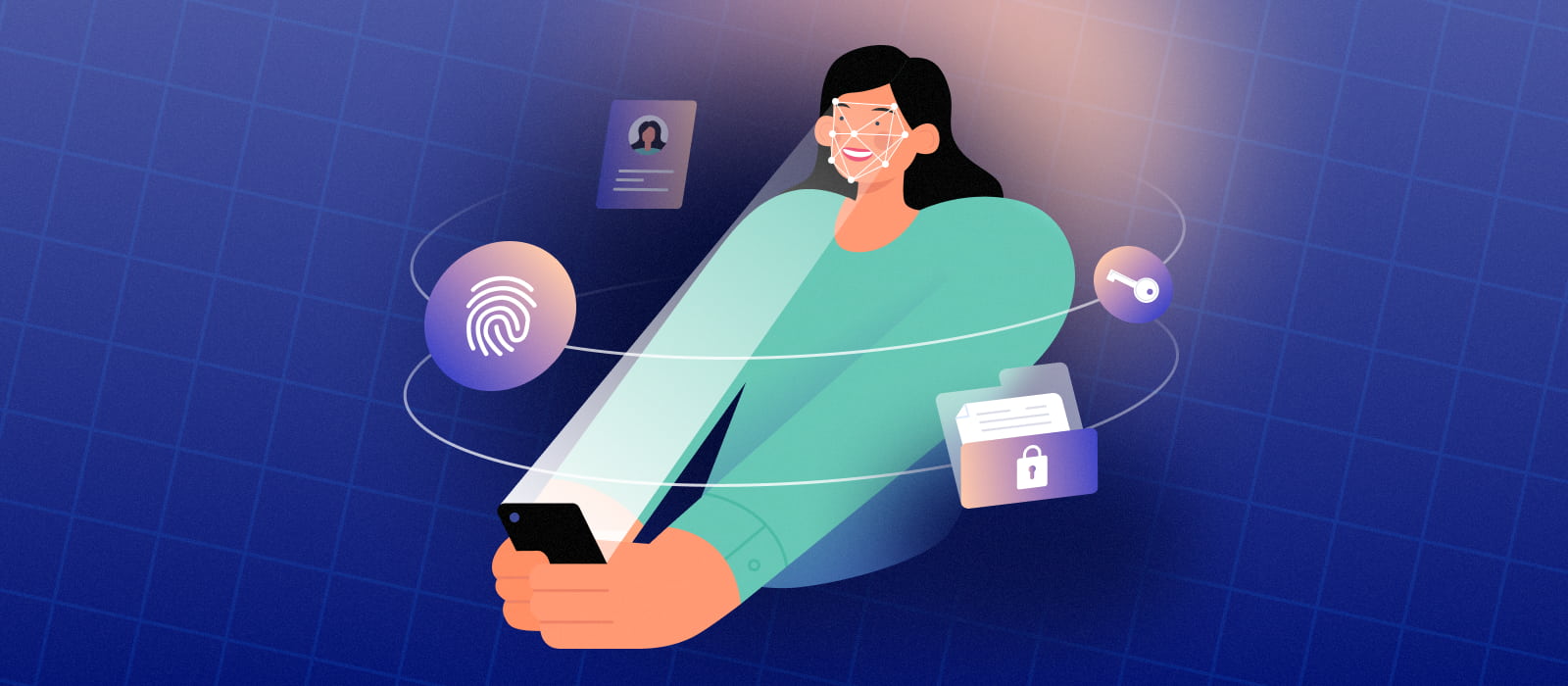Often, we don’t have a choice about whether to share our personal data or not, though we would all like to better protect our privacy. Decentralized identifiers can give us back control over our data, but how is that even possible?
Each time we use a website or application, we must consent to the use of our personal data. But the problem is that there is no choice: if you don’t click that button, you simply won’t be able to use the application.
The good news is that the situation is changing. Centralization is currently being replaced by decentralization, which no longer involves central data storage and collection.
Even more importantly, users will soon be able to better protect their data and choose whether to share it or not, thanks to decentralized identifiers (DIDs). Read on to find out more about what they are, how they work, and what benefits they bring to businesses and end users.
Let’s get started!
What are decentralized identifiers?
Decentralized identifiers are basically lines of letters and numbers that together create a unique digital identifier registered and stored on the blockchain or other kind of distributed ledger technology. They are always independent from any centralized authority and don’t even contain any personal information in themselves.
DIDs can be used to identify not only a real person, but also a product, location, organization, IoT device, or even something that does not physically exist like an idea or concept.
In addition to this, it is possible to create more than one digital identity and use them on various platforms. Although this does protect privacy, it creates an issue of concern: such freedom and anonymity can be abused, since it’s almost impossible to trace who exactly is hiding behind a decentralized identity.
Echo DeFi is a fully decentralized platform with top liquidity and fair token distribution. Check it out!
What are the types of decentralized identifiers?
There are two types of DIDs: public and private.
![]()
The distinction between them is quite logical: public DIDs are publicly identifiable, for example in the case of a passport issued by a government agency, and private DIDs are used to create a secure channel for communication between two parties without anyone else having access to it.
When exchanging private DIDs, no one else will even know that the channel has been created and what’s happening there, since there is no third party to control it. The entities behind DIDs have full control over their newly created channel and communications.
Is there any standard for decentralized identifiers?
Yes, there is. The idea of decentralized identifiers was conceptualized and standardized by the World Wide Web Consortium (W3C).
The W3C Recommendation published by the DID Working Group on July 19, 2022 described W3C decentralized identifiers’ syntax, core architecture, properties, data model, and operations. It has become a vital document for those in the blockchain development community seeking to take a more unified approach to DID creation, deployment, and adoption.
What advantages do DIDs offer and why do (or don’t) we need them?
A decentralized identifier offers several advantages over traditional methods such as physical IDs or centrally stored and controlled digital identities. These include better privacy and security, fraud protection and complete control over a person’s own data. Let’s take a closer look at each of these benefits.
- Better privacy and control of data
We’ll give you an example. You’ve issued a digital passport and stored it in your digital wallet. Tonight you decided to go clubbing, but taking a physical passport there is not very safe: you may have too much fun and lose it :D. So there you are, standing at the club entrance and the security guard is questioning your age and asking for your passport to confirm it.
On the one hand, you didn’t bring your physical passport, but on the other hand, you don’t want to show them your full name, exact date of birth or ID number. All you need to do is simply generate a QR code from your wallet and give it to the security guards to scan it.
By exchanging decentralized identifiers, that person and you will create a secure connection and the information will be verified without revealing your personal data.
In this way you get to choose whether to share data or not, and all control over your data remains in your own hands.
- Higher security
Digital decentralized identifiers are generated, registered, and secured using cryptography. Cryptography allows you to issue two types of keys: public and private. Private keys are known only to the key owner and are never shared with the public. Public keys, for their part, are widely distributed.
This type of pairing can perform two major functions: authentication and encryption. For authentication, the public key can confirm that the message was sent by the recipient, while for encryption, only the person with the private key can decrypt it.
- Protection against fraud
By implementing DIDs, certificate-issuing organizations can provide fraud-resistant credentials. Organizations that receive IDs, in turn, can instantly verify the authenticity of the credentials and be sure that the data wasn’t falsified.
- No metadata collection
Here we should show that popular meme with Chandler, Phoebe, and Monica from Friends where they are trying to listen in on a conversation behind a wall. This kind of represents how our social media apps eavesdrop on our talks with friends when we are thinking about buying something. Sometimes it seems that you only just thought about some purchase and ads are already popping up everywhere.
A decentralized identifier does not collect any metadata and, consequently, does not send it to third parties. Thus, users of platforms that provide the ability to create DIDs will forget what it is like to be targeted with ads.
DIDs are also a key component of Web5 — a decentralized environment of the future. Find out how it will work and how DIDs will be used there
However, there is a fly in the ointment: users may abuse anonymity, and no one will ever know who is behind a certain identity. In addition to this, the technology is quite new and W3C and the community are still working to improve its standard.
How do decentralized identifiers work?
Technically speaking, a decentralized identifier is a string that contains a URI scheme, DID method, and DID method-specific identifier.
A DID example looks like this: did:method:1234567890abcdefjhi. Each DID is converted into a DID document containing the cryptographic material and other metadata for managing the DID.
To understand how DIDs work, we need to get familiar with three basic definitions: DID subject, DID method, and DID document. We mentioned them earlier and now it’s time to find out what they are really for.
A DID subject is the thing that’s behind the digital identity. This can be a real person, a product, a device, a location, or a company.
A DID document is a set of data that contains information about a DID subject, and mechanisms that make the identifier work, such as public keys and pseudonymous biometrics. In fact, this is what the subject will use to authenticate themselves and prove that the identity does belong to them.
And, finally, a DID method is the mechanism that provides the full functionality of DIDs and DID documents. It allows you to create, read, update or deactivate an identifier and document on the blockchain or on any other DLT.
This is how decentralized identifiers look from the inside and how developers create and operate them. As for the end user, they may not even know the entire process. If the app enables its users to create a DID, they will sign up for a digital wallet, follow a few steps to create a digital identity, and store it in the wallet. Each time they need to use the identity, they will generate a QR code to verify it and access services.
What are DID use cases and real-life applications?
DIDs are suitable for any industry dealing with certificates and credentials. This is especially true for those who want to optimize data authentication, prevent identity fraud and data breaches, or simply help users protect their privacy.
These days, DIDs are being introduced to supply chain, healthcare, government, tourism, and education. Let’s consider a few use cases from some of these areas.
![]()
Health app for COVID-free travel
IATA Travel Pass is a health app that allows you to manage your COVID-19 testing certificates and vaccinations while traveling. The application was developed by Evernym for the International Air Transport Association (IATA).
The solution, which utilizes decentralized identifiers, helps users maintain their privacy while enabling airlines, governments and other organizations to instantly check COVID-19 test results and vaccines in a very secure manner and without the risk of exposing passengers’ personal information.
The key feature is that there is no central database for storing and using the data. Passengers are the ones who are in complete control of their private data and can decide for themselves whether or not to share it with airlines.
Digital identities for refugees
The Ministry of Foreign Affairs of the Republic of Türkiye, together with the United Nations Development Programme (UNDP) and the Istanbul Chamber of Commerce, piloted Tykn’s Self-Sovereign Identity Platform that aimed to help increase refugee employability and financial independence. The solution leverages decentralized identifiers (DIDs) as they are an integral part of the platform.
The decision has allowed the authorities to simplify the process of issuing work permits for refugees so that they can find work faster and become financially stable and independent. It was especially important to issue digital documents that were protected from unauthorized access and easily verifiable anywhere and at any time.
DIDs in a blockchain ecosystem
PixelPlex, a blockchain development company, has built a blockchain ecosystem with a Layer 2 protocol called Echo. The developer created and implemented its own decentralized identification mechanism to guarantee greater data security for its network users.
It’s worth noting that this newly-created and sophisticated mechanism was approved and listed by the W3C.
The aforementioned examples show that developers can create and implement decentralized identities in a wide variety of projects that require better data privacy and easier authentication. If you are planning to add this mechanism to your application, whether in the field of retail, logistics, workforce or any other area, finding and hiring an experienced development team will be a must.
Learn more about LaneAxis — a decentralized blockchain-powered solution for logistics and transportation
What does the future hold for DIDs?
Even though decentralized identifiers are still in their infancy and enterprises and governments are only piloting and testing the technology, DIDs have the potential to become a popular and solid tech as there is great interest from businesses and audiences in its development.
We are also moving towards a new decentralized era known as Web3. This may be surprising, but there are already ideas out there for Web5, in which decentralized identifiers will become key components and an integral part of our digital future.
That future is not so far away, and if businesses and organizations want to remain competitive and continue to thrive, they need to learn blockchain, DLT, and decentralized identities today to be ready for new changes.
Our PixelPlex blockchain developers can help you take the first steps towards decentralization and create solutions that will change your users’ lives for the better. We will build decentralized apps that provide high levels of security, excellent privacy protection, and good scalability, and most importantly, that will boost your business revenue.
Do not put off the future; it’s already here!




